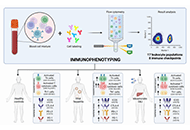Immunophenotyping to improve the mechanistic understanding of idiosyncratic drug-induced liver injury: clinical implications and future directions
The late event onset of a fraction of idiosyncratic drug-induced liver injury (DILI) cases and the link observed by genome-wide association studies (GWASs) of certain human leucocyte antigen (HLA) a
[...] Read more.
The late event onset of a fraction of idiosyncratic drug-induced liver injury (DILI) cases and the link observed by genome-wide association studies (GWASs) of certain human leucocyte antigen (HLA) alleles with DILI due to specific drugs support the crucial role of the immune system (both innate and adaptive) in the pathogenesis of DILI. Recent advances in both flow and mass cytometry have allowed the profiling of all major immune cell types in a given sample. Therefore, determining the lymphocyte populations in samples from patients with DILI would facilitate the development of specific biomarkers for DILI diagnosis and prognosis. To date, a few studies have explored the immune landscape in DILI. In a recent study of leukocyte immunophenotyping using flow cytometry from the Spanish DILI Registry, an important role of adaptive immune response in DILI is suggested. DILI patients had significantly higher levels of T helper 1 (Th1) cells and activated helper and cytotoxic T cells than healthy controls. Furthermore, the increased expression of negative immune checkpoints and ligands in DILI patients could reflect a restoration of the immune homeostasis. Differences in the profile of cytokines in DILI patients from the Drug-Induced Liver Injury Network (DILIN) also suggest an involvement of both innate and adaptive immune systems in DILI development and prognosis. Moreover, several studies based on immunophenotyping of liver infiltrates showed a distinctive pattern of cellular infiltrates in patients with immune checkpoint inhibitors (ICIs)-DILI, with lower levels of plasma cells, CD20+ B cells and CD4+ T cells than in autoimmune hepatitis (AIH) patients. These pioneering studies highlight the importance of immunophenotyping for the mechanistic understanding of DILI. In this review, available data on immunophenotyping in DILI are gathered, and the potential clinical applications of cutting-edge, novel immunophenotyping techniques are discussed.
Alejandro Cueto-Sánchez ... Marina Villanueva-Paz
View:1918
Download:65
Times Cited: 0
The late event onset of a fraction of idiosyncratic drug-induced liver injury (DILI) cases and the link observed by genome-wide association studies (GWASs) of certain human leucocyte antigen (HLA) alleles with DILI due to specific drugs support the crucial role of the immune system (both innate and adaptive) in the pathogenesis of DILI. Recent advances in both flow and mass cytometry have allowed the profiling of all major immune cell types in a given sample. Therefore, determining the lymphocyte populations in samples from patients with DILI would facilitate the development of specific biomarkers for DILI diagnosis and prognosis. To date, a few studies have explored the immune landscape in DILI. In a recent study of leukocyte immunophenotyping using flow cytometry from the Spanish DILI Registry, an important role of adaptive immune response in DILI is suggested. DILI patients had significantly higher levels of T helper 1 (Th1) cells and activated helper and cytotoxic T cells than healthy controls. Furthermore, the increased expression of negative immune checkpoints and ligands in DILI patients could reflect a restoration of the immune homeostasis. Differences in the profile of cytokines in DILI patients from the Drug-Induced Liver Injury Network (DILIN) also suggest an involvement of both innate and adaptive immune systems in DILI development and prognosis. Moreover, several studies based on immunophenotyping of liver infiltrates showed a distinctive pattern of cellular infiltrates in patients with immune checkpoint inhibitors (ICIs)-DILI, with lower levels of plasma cells, CD20+ B cells and CD4+ T cells than in autoimmune hepatitis (AIH) patients. These pioneering studies highlight the importance of immunophenotyping for the mechanistic understanding of DILI. In this review, available data on immunophenotyping in DILI are gathered, and the potential clinical applications of cutting-edge, novel immunophenotyping techniques are discussed.
 Immunophenotyping to improve the mechanistic understanding of idiosyncratic drug-induced liver injury: clinical implications and future directionsOpen AccessReviewThe late event onset of a fraction of idiosyncratic drug-induced liver injury (DILI) cases and the link observed by genome-wide association studies (GWASs) of certain human leucocyte antigen (HLA) a [...] Read more.Alejandro Cueto-Sánchez ... Marina Villanueva-PazPublished: April 26, 2023 Explor Dig Dis. 2023;2:56–76
Immunophenotyping to improve the mechanistic understanding of idiosyncratic drug-induced liver injury: clinical implications and future directionsOpen AccessReviewThe late event onset of a fraction of idiosyncratic drug-induced liver injury (DILI) cases and the link observed by genome-wide association studies (GWASs) of certain human leucocyte antigen (HLA) a [...] Read more.Alejandro Cueto-Sánchez ... Marina Villanueva-PazPublished: April 26, 2023 Explor Dig Dis. 2023;2:56–76 Zebrafish as a model for drug induced liver injury: state of the art and beyondOpen AccessReviewZebrafish as a preclinical drug induced liver injury (DILI) model provides multiple advantages ranging from ease of breeding and maintenance, availability of different strains and transgenic fish am [...] Read more.Gulcin Cakan-Akdogan ... Ozlen KonuPublished: April 26, 2023 Explor Dig Dis. 2023;2:44–55
Zebrafish as a model for drug induced liver injury: state of the art and beyondOpen AccessReviewZebrafish as a preclinical drug induced liver injury (DILI) model provides multiple advantages ranging from ease of breeding and maintenance, availability of different strains and transgenic fish am [...] Read more.Gulcin Cakan-Akdogan ... Ozlen KonuPublished: April 26, 2023 Explor Dig Dis. 2023;2:44–55 Diagnostic workup of suspected hereditary cholestasis in adults: a case reportOpen AccessCase ReportHereditary cholestasis comprises a broad spectrum of clinical phenotypes of varying severity. Severe forms such as progressive familial intrahepatic cholestasis (PFIC) mostly affect children with di [...] Read more.Carola Dröge ... Verena KeitelPublished: April 21, 2023 Explor Dig Dis. 2023;2:34–43
Diagnostic workup of suspected hereditary cholestasis in adults: a case reportOpen AccessCase ReportHereditary cholestasis comprises a broad spectrum of clinical phenotypes of varying severity. Severe forms such as progressive familial intrahepatic cholestasis (PFIC) mostly affect children with di [...] Read more.Carola Dröge ... Verena KeitelPublished: April 21, 2023 Explor Dig Dis. 2023;2:34–43